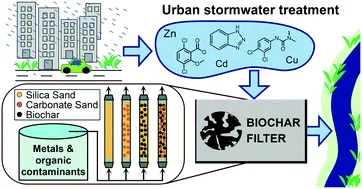Urban stormwater carries dissolved organic and metal contaminants that pose risks to water supplies and the environment. Green infrastructure elements such as biofilters have the potential to capture and treat urban stormwater prior to infiltration to groundwater. Because conventional sand-based biofilters often fail to eliminate dissolved contaminants from stormwater, there is a need to improve biofilter treatment efficiency. In our study, we investigated four different wood-derived biochars for the removal of seven trace organic contaminants (TrOCs, atenolol, benzotriazole, dicamba, diuron, fipronil, mecoprop, terbutryn) and five metals (cadmium, copper, lead, nickel, zinc). Three biochars were produced at pyrolysis temperatures of 400 °C, 580 °C, and 750 °C, and one biochar of biomass gasification (1100–1400 °C). Batch experiments conducted with synthetic stormwater showed that the removal capacity of the biochars increased with increasing production temperature and specific surface area. The gasification biochar outperformed the three pyrolysis biochars and was further tested in flow-through column experiments operated for more than eight months and 4000 pore volumes. The least retained organic contaminant was dicamba followed by fipronil and terbutryn. Using a 1-D forward prediction intraparticle diffusion-limited sorption model, 20% breakthrough of dicamba was estimated to occur at 1100 and 5300 pore volumes in biochar-amended sand filters containing 1 to 10 weight percent biochar, respectively. Based on these results, case study calculations for a full-scale biochar filter in Los Angeles, CA, suggest potential service lifetimes of five years and longer when using dicamba as an indicator compound for early TrOC breakthrough.
